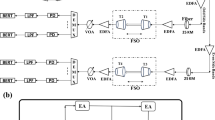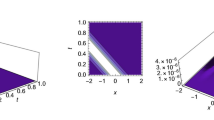Abstract
Four-wave mixing effects mitigation techniques in wavelength division multiplexing systems which utilize hybrid configurations of dispersion compensating devices like dispersion compensating fiber, fiber bragg grating and optical phase conjugator are presented in this paper. These configurations have been simulated and the output results have been compared to find out the best alternative for four-wave mixing mitigation purpose. The comparison is carried out on the basis of parametric analysis and optimized parameter values. Optimization of important parameters has been done keeping a constraint on values of quality factor and minimum bit error rate values.




Similar content being viewed by others
References
Ahmed, J., Ashiq, H., Siyal, M. Y., Manzoor, H., & Massod, A. (2014). Parametric analysis of four-wave mixing in DWDM system. Optik, 125, 1853–1859.
Betti, S., Giaconi, M., & Nardini, M. (2003). Effect of four-wave mixing on WDM optical systems: A statistical analysis. IEEE Photonics Technology Letters, 15(8), 1079–1081.
Agrawal, G. P. (2000). Nonlinear fiber optics (Chap. 10) (2nd ed.). San Diego: Academic Press.
Singh, P., & Singh, N. (2007). Nonlinear effects in optical fibers: Origin, management and application. Progress in Electromagnetics Research, PIER, 73, 249–275.
Kaur, G., Singh, M. L., & Patterh, M. S. (2010). Effect of fiber nonlinearities in a WDM transmission system. Optik, 121, 889–896.
Sharma, V., & Kaur, Ramandeep. (2013). Implementation of DWDM system in the presence of four wave mixing (FWM) under the impact of channel spacing. Optik, 124, 3112–3114.
Rouf, A., & Islam, M. S. (2012). A new approach of unequally spaced channel allocation for FWM crosstalk suppression in WDM transmission system. In 7th international conference on electrical and computer engineering (pp. 35–38).
Forghieri, F., Tkach, R. W., Chraplyvy, A. R., & Marcuse, D. (1994). Reduction of FWM crosstalk in WDM system using unequally spaced channels. IEEE Photonics Technology Letters, 6(86), 754–756.
Balani, W., & Saxena, M. (2013). Unique filtering and wavelength-stabilization through FBG in WDM/DWDM networks. International Journal of Computer Applications, 74(5), 20–23.
Singh, A., Sharma, A. K., & Kamal, T. S. (2009). Investigation on modified FWM suppression methods in DWDM optical communication systems. Optics Communications, 282, 392–395.
Kaur, B., Sharma, A. K., & Kapoor, V. (2013). Performance analysis of WDM RoF-EPON link with and without DCF and FBG. Optics and Photonics Journal, 3, 163–168.
Ajmani, M., & Singh, P. (2015). FWM in WDM system, effects and techniques to minimize. In 5th international conference on advanced computing and communication technology, IEEE (pp. 385–389).
He, G. S. (2002). Optical phase conjugation: Principles, techniques, and applications. Progress in Quantum Electronics, 26, 131–191.
Abed, H. J., Din, N. M., AL-Mansoori, M. H., Fadhil, H. A., & Abdullah, F. (2013). Recent four-wave mixing suppression methods. Optik, 124, 2214–2218.
Noshada, M., & Rostamia, A. (2012). FWM minimization in WDM optical communication systems using the asymmetrical dispersion-managed fibers. Optik, 123, 758–760.
Kaur, G., & Patterh, M. S. (2014). Suppression of four wave mixing effect in WDM systems with hybrid modules. Optik, 125, 3894–3896.
Abd, H. J., Al-Mansoori, M. H., Din, N. M., Abdullah, F., & Fadhil, H. A. (2014). Priority-based parameter optimization strategy for reducing the effects of four-wave mixing on WDM system. Optik, 125, 25–30.
Kaur, G., & Singh, M. L. (2009). Effect of four waves mixing in a WDM optical fiber system. Optik, 120, 268–273.
Author information
Authors and Affiliations
Corresponding author
Additional information
Publisher's Note
Springer Nature remains neutral with regard to jurisdictional claims in published maps and institutional affiliations.
Rights and permissions
About this article
Cite this article
Ajmani, M., Singh, P. & Kaur, P. Hybrid Dispersion Compensating Modules: A Better Solution for Mitigating Four-Wave Mixing Effects. Wireless Pers Commun 107, 959–971 (2019). https://doi.org/10.1007/s11277-019-06311-3
Published:
Issue Date:
DOI: https://doi.org/10.1007/s11277-019-06311-3




